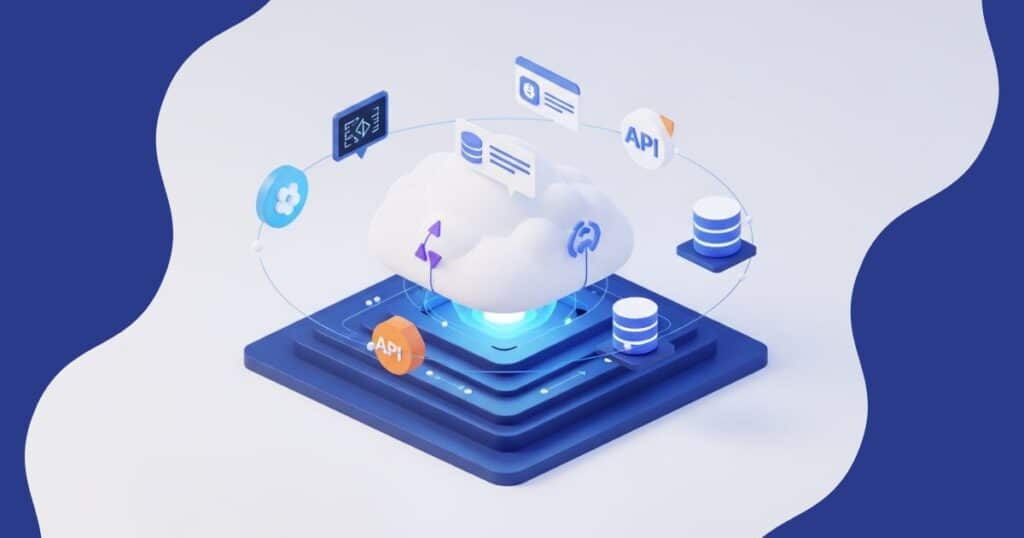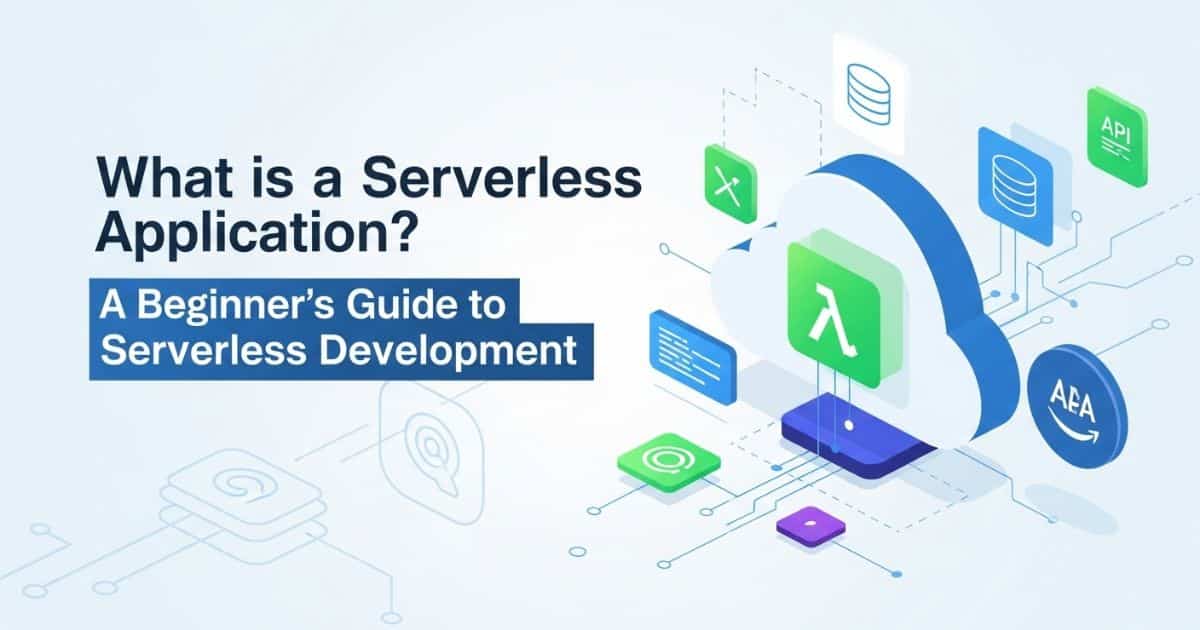Table of contents:
Understanding the Core Concept: What is a Serverless Application? A Deeper Look at How Serverless Works The Clear Advantages of Serverless Application Development Common Use Cases for Serverless Applications Serverless Development with AWS: An Ecosystem Overview Overcoming the Challenges of Serverless Your First Steps into Serverless Development The Path Forward: Your Serverless JourneyServerless has become one of the most talked-about approaches in modern software development. It’s an approach that fundamentally shifts the focus of building applications. Instead of worrying about servers, scaling, or infrastructure, developers can simply concentrate on writing code that solves a specific problem. But what exactly does that mean in practice, and why is it reshaping how we build and deploy software? Let’s break down the concept of a serverless application and understand its profound impact.
Understanding the Core Concept: What is a Serverless Application?
At its heart, a serverless application is software built and run without the need for a developer to manage any physical or virtual servers. This doesn’t mean the servers vanish into thin air. They are still very much a part of the architecture, but their management—including provisioning, patching, scaling, and maintenance—is entirely handled by a third-party cloud provider like Amazon Web Services (AWS), Google Cloud Platform, or Microsoft Azure.
The fundamental idea is simple yet powerful: you create a piece of code, often a single function, and the cloud provider takes care of running it for you only when it’s needed. You upload your code, configure what triggers it (an event), and the rest is automated. This model is often referred to as Function-as-a-Service (FaaS), and it’s the cornerstone of modern serverless solutions.
In a traditional setup, you might need to run a server around the clock to handle potential requests, even during periods of low activity. With a serverless approach, your code is dormant until a specific event wakes it up.
For example:
Imagine you have a mobile app where users can upload photos. In a traditional setup, you’d need a server constantly running to listen for these uploads, and you’d have to manually scale it up for high traffic times like a holiday or a major event.
With a serverless approach, you write a function (e.g., an AWS Lambda function) that is triggered the moment a user uploads a photo to a storage service like Amazon S3. This function might resize the image, apply a watermark, and save it to a database. Once the task is complete, the function stops running, and you are not charged for any idle time. This is a core benefit of Serverless Application Development you are only billed for the exact duration your code is running and the resources it consumes.
A Deeper Look at How Serverless Works
The engine behind any serverless application is its event-driven nature. The entire system is built around a simple principle: an event triggers a function.
Here’s a more detailed breakdown of the process:
- Event Trigger: Everything starts with an event. This could be an API call from a front-end application, a new file being uploaded, a database record being updated, a scheduled cron job, or a message appearing on a queue.
- Function Execution: In response to the event, the cloud provider’s serverless platform (like AWS Lambda) automatically spins up an execution environment. It runs your code—your function—in a secure, isolated container.
- Automatic Scaling: As more events occur simultaneously, the cloud provider automatically creates more instances of your function to handle the increased load. This means your application can handle massive spikes in traffic without you having to manually configure load balancers or add more servers. The system scales effortlessly, on-demand.
- Billing by Usage: When the function finishes its task, the execution environment is shut down. You are billed only for the milliseconds of computation time and the amount of memory your function used. This pay-per-use model can lead to significant cost savings, especially for applications with inconsistent or spiky traffic patterns.
This fundamental model allows developers to focus on the business logic, rather than the operational complexities of managing servers. It’s a paradigm shift that enables faster time-to-market and greater agility for modern software solutions.
The Clear Advantages of Serverless Application Development

The rise of serverless isn’t just about a new technology; it’s about a new way of thinking about building software that brings tangible benefits to the business.
- Significant Cost Efficiency: The pay-per-use billing model is perhaps the most compelling advantage. You are not paying for idle server time. This is particularly beneficial for applications with variable workloads or for startups and projects in their early stages. The cost of running a serverless app can be a fraction of what a traditional, always-on server costs. Businesses, whether small startups in Ahmedabad or large enterprises globally, can significantly reduce their infrastructure expenditure by adopting serverless.
- Massive Scalability, Effortlessly: Scaling is one of the biggest challenges in traditional development. With serverless, this problem is solved automatically. Whether your application has 10 users or 10 million, the cloud provider handles the scaling dynamically and transparently. You don’t need to manually configure autoscaling groups or worry about a sudden surge in traffic crashing your service. This automatic scaling ensures your application is always available and performs optimally, regardless of demand.
- Faster Development and Deployment: By abstracting away the infrastructure, developers can concentrate on what they do best: writing code. They don’t need to spend time on server provisioning, patching, or configuration management. This leads to a much faster development lifecycle, allowing teams to iterate more quickly and get products to market sooner. This rapid development capability is a key reason many companies are embracing the Serverless Framework and similar tools to accelerate their innovation.
- Reduced Operational Overhead: With serverless, the responsibility for managing the underlying servers, operating systems, and even basic security patches falls to the cloud provider. This frees up your development and operations (DevOps) teams to focus on higher-value tasks, reducing the overall operational burden and the need for extensive infrastructure expertise. This means less time spent on routine maintenance and more time on actual product enhancement.
- Built-in Security: Cloud providers invest heavily in securing their platforms. Serverless architectures benefit from this immediately, as the functions run in secure, isolated environments. While you are still responsible for your code’s security, the underlying infrastructure is managed and updated automatically, reducing the risk of vulnerabilities from unpatched servers. This foundational security layer provides a strong starting point for any application.
Common Use Cases for Serverless Applications
The versatility of a serverless architecture means it can be applied to a wide range of problems, from simple utilities to complex, enterprise-grade solutions across various industries.
- Microservices and APIs: Building a REST API is one of the most popular use cases for serverless. Each API endpoint can be its own serverless function. This allows for a granular, microservices-based approach where each service is isolated, easy to deploy, and can be scaled independently. This modularity is perfect for complex applications that need to evolve rapidly.
- Real-time Data Processing: Serverless functions are excellent for handling streams of data from various sources, such as IoT devices, log files, or social media feeds. A function can be triggered whenever new data arrives, processing it on the fly, and then sending it to a database or a storage service. This is critical for applications requiring immediate insights or responses, such as real-time analytics dashboards or fraud detection systems.
- Mobile and Web Backends: For mobile apps and single-page web applications, serverless provides a powerful backend without the need to manage a full server. Functions can handle user authentication, database interactions, file uploads, and more, all triggered directly from the client. This simplifies backend development significantly for dynamic online platforms.
- Chatbots and Voice Assistants: The event-driven model is a natural fit for conversational applications. An event (a user’s message or voice command) triggers a function that processes the request and generates a response. This allows for highly responsive and scalable AI-powered interactions.
- File Processing: As mentioned earlier, serverless is ideal for tasks like image resizing, video transcoding, or PDF generation. The function runs only when a new file is uploaded, making it a highly cost-effective solution for media-heavy applications and document management systems. This avoids the need for dedicated, always-on servers for sporadic processing tasks.
- Automated Backend Tasks: Serverless functions are perfect for running scheduled tasks (like cron jobs) or automating responses to system events, such as database backups, sending daily reports, or cleaning up old data. This reduces manual intervention and improves operational efficiency.
Serverless Development with AWS: An Ecosystem Overview
Amazon Web Services (AWS) is a leader in the serverless space, providing a comprehensive ecosystem of services that work together to create robust and scalable applications. A full-stack AWS Serverless Architecture often combines several key components:
- AWS Lambda: The core of the FaaS model. It’s where your code runs. Lambda supports multiple languages like Python, Node.js, and Java, offering flexibility for developers.
- Amazon API Gateway: A fully managed service that allows you to create, publish, and secure APIs. It acts as the “front door” for your serverless application, receiving HTTP requests and routing them to the appropriate Lambda functions.
- Amazon S3 (Simple Storage Service): A highly scalable object storage service. It’s perfect for storing static website content, user uploads, and serving as a trigger source for Lambda functions.
- Amazon DynamoDB: A fully managed, serverless NoSQL database. It’s designed for high-performance applications and automatically scales to handle any amount of traffic, making it a perfect partner for Lambda.
- Amazon SQS (Simple Queue Service) & SNS (Simple Notification Service): These messaging services allow for asynchronous communication between different parts of your application, ensuring high availability and fault tolerance in distributed systems.
- AWS Step Functions: For orchestrating complex workflows involving multiple serverless functions and services, Step Functions provide a visual way to define and manage sequential or parallel execution flows.
- AWS Amplify: A set of tools and services that can significantly accelerate the development of full-stack serverless applications, particularly for web and mobile frontends.
For businesses aiming to leverage this powerful ecosystem without extensive in-house expertise, partnering with an expert is key. Experienced AWS Consulting partners can help navigate the complexities, design an optimal architecture, and implement a secure, scalable serverless solution. Companies like Perception System specialize in guiding businesses through these transitions, ensuring they harness the full potential of cloud technologies. For a deeper dive into AWS serverless offerings, you can consult the official AWS Serverless Documentation.
Overcoming the Challenges of Serverless

While serverless development offers immense benefits, it’s not without its own set of challenges that developers must be aware of and plan for.
- Cold Starts: When a function hasn’t been used for a while, the first time it’s invoked, the cloud provider needs to provision a new execution environment. This can introduce a slight latency (a “cold start”), which might be noticeable in latency-sensitive applications. Strategies like “provisioned concurrency” can mitigate this for critical functions.
- Debugging and Monitoring: Serverless applications are inherently distributed. A single user request might trigger a cascade of functions across different services. This distributed nature can make debugging and performance monitoring more complex than in a monolithic application. Robust logging, tracing (e.g., AWS X-Ray), and specialized monitoring tools are essential.
- Vendor Lock-in: The tight integration with a specific cloud provider’s ecosystem can make it challenging to migrate your application to another provider in the future. However, using frameworks like the Serverless Framework AWS can help abstract some of these platform-specific details, making code more portable.
- Statelessness: Serverless functions are stateless, meaning they cannot maintain data between invocations. This requires developers to use external services like databases (DynamoDB), caches (ElastiCache), or storage (S3) for storing state. This architectural shift can be a new concept for developers accustomed to stateful applications and requires careful design.
- Deployment and Version Management: Managing numerous small functions, each with its own version, can become complex. Effective tooling and CI/CD pipelines are crucial for streamlined deployments and rollbacks.
Your First Steps into Serverless Development
Getting started with serverless is more accessible than you might think. A structured approach can help you move from a basic understanding to building your first application.
- Choose a Cloud Provider: AWS, Azure, and GCP all have robust serverless offerings. For many, AWS is a great starting point due to its maturity and extensive ecosystem.
- Learn the Core Concepts: Get a solid grasp of FaaS (like AWS Lambda) and the event-driven model. Understand how different services interact within a serverless ecosystem.
- Use a Framework: To simplify the process of defining and deploying your serverless application, use a framework. The Serverless Framework (you can find more details on the Serverless Framework Official Site) is a popular, open-source choice that works with multiple providers. AWS also offers its own tools like the AWS SAM (Serverless Application Model).
- Start Small: Build a simple “Hello World” function. Connect it to an API Gateway endpoint. Get comfortable with the deployment and invocation process. This is the foundation for any larger project.
- Build a Basic Project: Try to build a more functional, yet simple, application. For example, a URL shortener that uses Lambda, API Gateway, and DynamoDB. This will help you understand how the different components fit together.
- Seek Expertise: For complex projects or enterprise-scale Serverless App Development, working with a team that has deep experience is invaluable. Whether you’re building sophisticated web portal development services or specific solutions like an ats software development system, expert guidance can save time and resources.
As you consider expanding your capabilities, remember that a strong technology partner can bridge the gap. We specialize in everything from serverless solutions to specialized projects like moodle development and helping you hire a skilled HubSpot CMS Developer.
The Path Forward: Your Serverless Journey
Serverless application development is more than just a passing trend—it’s a fundamental evolution in how we build and deploy software. By abstracting away the complexities of server management, it empowers developers to build faster, scale more efficiently, and innovate without the traditional infrastructure overhead. While challenges like cold starts and debugging exist, the benefits of cost savings, automatic scaling, and a faster time-to-market make serverless an incredibly compelling choice for modern applications.
Whether you’re building a simple API, a microservices-based system, or a large-scale data processing solution, embracing the serverless model offers unparalleled flexibility and agility. It allows businesses to focus on delivering value to their customers rather than managing intricate infrastructure. If you’re ready to explore how this approach can transform your business, feel free to contact us for a consultation.




